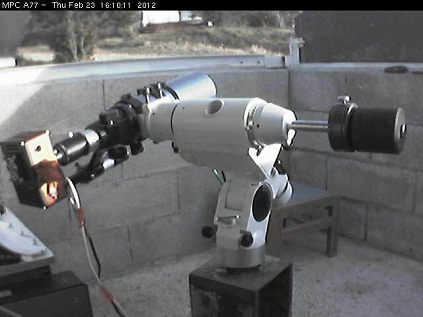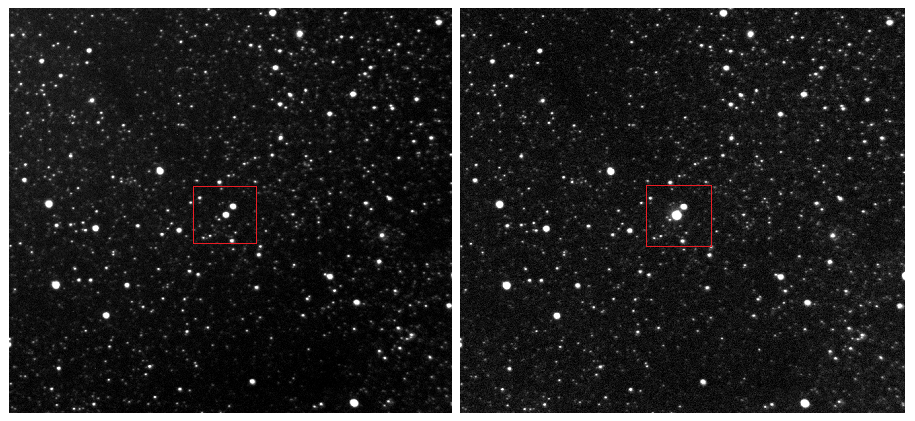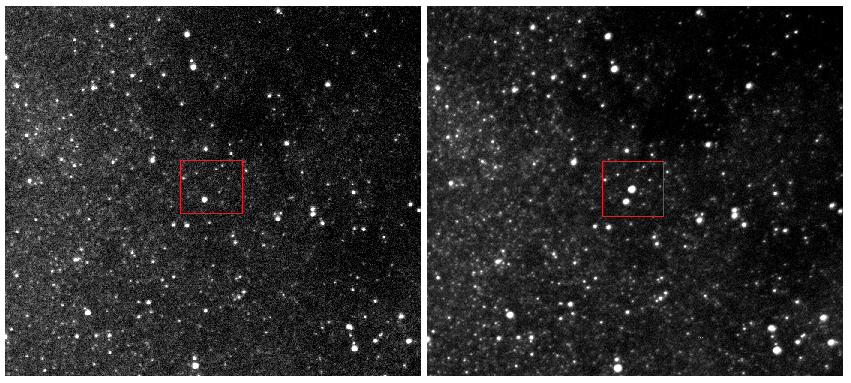Nova Survey
|
This project is a collaboration between Francois Kugel and myself.
The setup is located in Observatoire de Chante-Perdrix, Dauban (MPC A77).
See the pages from Francois for a description. We use an achromatic refractor d=80mm/f=400mm with a CCD camera ST8300 Sbig. The sensor is a full-frame CCD with 3352x2532 pixels. With this setup the field covered is about 2deg*2.5deg. The refractor is mounted onto a HEQ5Pro Sky-Watcher goto mount driven by Prism software. Francois is setting up the telescope every evening with clear sky, making the acquisitions over the night, taking calibration frames, remotely from his house nearby. Then I am logging in from my place in Netherlands to make the processing in the morning. We use the software TeamViewer. Every night, the 80mm refractor is imaging one of these two areas:
The limiting magnitude of our setup is around 14. So far, we did not discover any nova, but we found a very large amount of variable stars (several hundreds). We have set up a list of these variables, and an automatic script is running through our image archive and extracts the lightcurves. The results are shown below. |
 |
| Warning: the results are preliminary. The magnitudes are not calibrated (this is not trivial due to the IR filter cutting everything below 742nm and the very red Mira Ceti stars). The algorithm used to extract the magnitudes is also a draft version, e.g. it does not check the image background uniformity and thus many data points may be affected by clouds, or there may be artefacts. We are in the process of setting up the scripts for the various steps in the processing. All the possible errors will be checked carefully and corrected in the coming months. |
CYGNUS AREA
An eclipsing variable in one of our fields: U Sge.

AAVSO-VSX variable stars
Many objects for which we have detected a variability are in fact already known variable stars. See the following links:
| Type of variable | Number of targets observed (25 July 2012) |
| Mira Ceti (M) | |
| Eclipsing (E, EA, EB) | |
| Slow irregular (L, L:, LB) | |
| Semi-regular (SR, SRA, SRB) | |
| MISC | |
| Unknown | |
| Cepheids (CEP, DCEP) | |
| RR Lyrae (RR, RRAB, RRC) | |
| RV Tauri (RVA, RVB) | |
| UX Orionis (UXOR) | |
| Poorly studied irregular (I, IA, IB) | |
| Long period (LPV) | |
| AAVSO suspect | |
| TOTAL |
Suspect objects and discoveries
So far (25 July 2012) we have detected 257 variable objects, which are not already known as variable stars. About 75% are real discoveries of new variables, and 10% false alerts.
For the remaining 15% more measurements are needed.
Click here to see the lightcurves.
SAGITTARIUS-SCORPIO AREA
A picture of Nova Scorpii 2012. It appeared at beginning of June. We were not observing the area at this time.
Left = picture taken 27.07 May, right = picture taken 21.97 June.

AAVSO-VSX variable stars
In the Sco-Sgr fields the number of objects for which we have detected a variability is very large.
Many of them are already known variable stars. See the following links:
| Type of variable | Number of targets observed (25 July 2012) |
| Mira Ceti (M) | |
| AAVSO suspect | |
| Eclipsing (E, EA, EB) | |
| Semi-regular (SR, SRA, SRB) | |
| Unknown | |
| MISC | |
| W Virginis (CW, CWA, CWB) | |
| Cepheids (CEP, DCEP) | |
| RV Tauri (RV, RVA, RVB) | |
| RR Lyrae (RR, RRAB, RRC) | |
| Novae (N, NA, NB, NC) | |
| Poorly studied irregular (I, IA, IB) | |
| Long period (LPV) | |
| Slow irregular (L, L:, LB) | |
| Gamma Cassioppeiae (GCAS) | |
| Delta Scuti (DSCT) | |
| Unstudied with rapid light changes (S) | |
| Z Andromedae (ZAND) | |
| TOTAL |
Suspect objects and discoveries
So far (25 July 2012) we have detected 434 variable objects, which are not already known as variable stars. The rate of false alerts is significantly higher than for the Cygnus area, due to the lower declinations and higher density fields. Nevertheless a large number of the detected objects are serious candidates for discovery of new variables.
In general for many targets, more measurements are needed.
Click here to see the lightcurves.